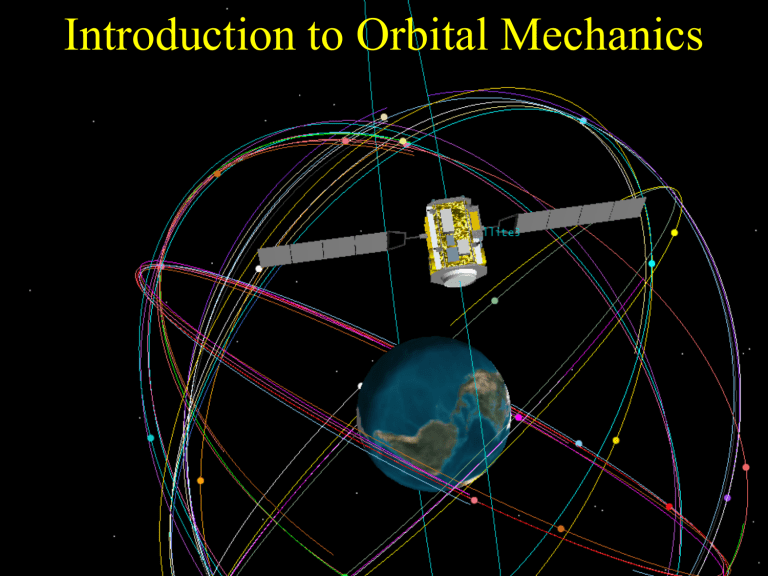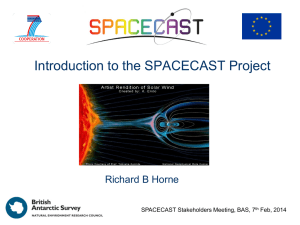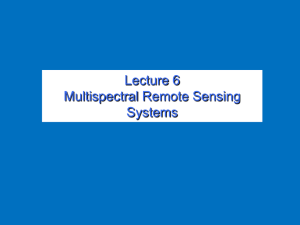PPT with Animation

Introduction to Orbital Mechanics
What is an Orbit?
A closed “path” around which a planet or satellite travels.
Graphic obtained from
Astronautics Primer by Jerry
Sellers.
Johannes Kepler discovered in the 1600’s that planets did not orbit in circles but rather in ellipses . Satellites, natural or man-made, also orbit the earth in ellipses.These elliptical orbits remain FIXED in space (the earth spins under a fixed orbit of a satellite).
What Is an Ellipse?
•
An ellipse is the two dimensional shape that is produced by a plane fully intersecting a cone.
•
Note that a plane intersecting the cone at a angle perpendicular to the cone’s center line will form a special ellipse called a circle.
What is an ellipse?
A
A
B
A circle is a set of points that are a fixed, constant distance from a center point (or focus). A = constant
Instead of a center, an ellipse has two focii. The sum of distances from each focii is a constant.
A+B = constant
A circle is simply an ellipse with both focii located at the same spot.
For satellites orbiting the earth, one of the focii is at the center of the earth. The other is simply an “empty” point. It may be within the boundaries of the earth or it may be beyond it.
What Is an Ellipse?
• a defines ½ the major axis length
• b defines ½ the minor axis length
• c is the distance from the center of the ellipse to either focal point
• For a circle, a and b are equal to the radius, and both focal points are colocated at the center of the ellipse
Orbits can be very diverse
Click to display Diverse.avi
How are orbits described?
Orbits are described by a set of parameters called orbital elements or the Keplerian elements.
The Keplerian element set consists of 6 parameters
(plus a time stamp):
2 of these describe the size and shape of an orbit
3 of these describe the orientation of the orbit in space
1 of these describes the location of the satellite within the orbit
Eccentricity (e)
Eccentricity describes the “roundness” of an orbit. It describes the shape of the ellipse in terms of how fat to wide it is.
Semi-major axis, a
Semi-minor axis, b e =
1 – b 2 a 2
Eccentricity (cont.)
This value is between 0 and 1 (for “closed” orbits).
Eccentricity of 0 means the orbit is circular.
An eccentricity of 1 or greater means the orbit is not “closed.”
Such would be used for interplanetary missions. Satellites in these types of orbits do not
“come back” to their starting point.
Eccentricity, continued
Values between 0 and 1 mean the orbit is “elliptical” e = .74
e = .60
e = .4
e = 0
Click to display Eccentricity.avi
Beyond eccentricity
Orbits may have the same eccentricity
(e) but be different sizes. There must be a Keplerian element which describes the SIZE of an orbit.
Semi-major axis, a
Semi-major axis
Major axis, 2a
Center of ellipse
Semi-major axis, a, describes the size of the ellipse. It is half of the largest diameter (the major axis) of the orbit.
The semi-major axis originates from the center of the orbit, but we are located on earth.
This makes semi-major axis difficult for us to visualize from our reference point.
Apogee
Important points on the orbit
**The “gee” part of the words refer to earth. Generic terms are apoapsis and periapsis.
Apogee altitude
Perigee altitude
Perigee
Apogee defines the point in an orbit that is farthest from earth.
Perigee describes the point in an orbit that is closest to earth.
Apogee altitude is the distance between the surface of the earth and apogee.
Perigee altitude is the distance between the surface of the earth and perigee.
Apogee, Perigee and Circular Orbits
“Apogee”
Apogee altitude
Perigee altitude
Apogee Altitude = Perigee Altitude
“Perigee”
• In a circular orbit, apogee altitude and perigee altitude are the same! (So, technically, a perfectly circular orbit has neither an apogee nor perigee. They are undefined. However, in reality perfectly circular orbits cannot be achieved.)
• In general, circular orbits can simply be described by their altitude . Semimajor axis is rarely used to describe circular orbits.
Semi-major axis
(
Altitude for circular orbits
)
Semi-major axis is the only (see below equation) orbital parameter that determines the orbital period.
Period = 2 p * a 3/2 m
Click to display Altitude.avi
m is a constant called the gravitational parameter.
Or translated as Kepler’s 3 rd Law:
The square of the period of a planet is proportional to the cube of its mean distance from the sun.
Semi-major axis (cont.)
• These orbits all have the same semi-major axis
(a), but their eccentricities (e) and their orientations around the earth are different.
• Observe their orbital periods.
Click to display semi_maj_Ax.avi
Describing the Orientation of the Orbit in Space
Orbits may have identical sizes and shapes (a and e), yet they can vary in their orientation in space.
3 additional Keplerian elements define this orientation:
• Inclination
• Right Ascension of the
Ascending Node
• Argument of perigee
Inclination (i)
Inclination is the angle between the earth’s equatorial plane and the plane of the orbit. It describes the “tilt” of the orbit.
i = 5 o i = 25 o i = 45 o i = 75 o
???
Which satellite will complete one orbit first?
Click to display Inclination.avi
We interrupt our regularly scheduled presentation on inclination to bring you important information regarding ground traces !
If a long string with a magic marker tied to the end of it were hung from a satellite, the path which the magic marker would trace over the ground is the ground trace. A ground trace is a projection of the satellite’s orbit onto the earth.
The satellite appears to move westward on
(most) conventional orbits because the earth is rotating eastward.
Click to display GroundTrace.wmv
Ground Traces (cont.)
After a full day the ground trace of a satellite with an approximate 90 minute orbital period would look like this. Because the earth is continually rotating below the orbit of the satellite the ground trace eventually spans all longitudes.
You can determine the inclination of an orbit simply by examining the ground trace!
Back to inclination!
Inclination determines the northern and southern latitude limits over which the satellite orbits. For example, a satellite with a 45 o inclination will have a ground trace ranging from 45 o north to 45 o south.
Inclination
(cont.)
An orbit with an inclination of 0 degrees is called an equatorial orbit . An orbit with an inclination of 90 degrees is called a polar orbit .
Inclination
(cont.)
A satellite in an equatorial orbit will only pass directly over the equator.
A satellite in polar obit will pass over the entire earth.
What Do Ground Traces Reveal?
2nd pass, 25 degrees west longitude
1 st pass, 0 degrees longitude
Based on what we have already learned about orbital parameters, we can determine both inclination and orbital period from a ground trace.
• Inclination is determined simply by noting the northern and southern latitude limits of the ground trace.
• Orbital period can be determined using a simple calculation.
Determining a satellite’s orbital period from its ground trace
1. Recall that the orbit of a satellite remains fixed in space, and the earth rotates underneath it.
2. The westward regression of the ground trace is due to the rotation of the earth.
3. Determine how many minutes it takes for the earth to rotate one degree:
1440 minutes/360 degrees = 4min/degree
4. Determine how many degrees per pass the satellite’s orbit regresses on consecutive orbits (equatorial crossing is a common reference point). We’ll use 25 degrees as an example.
5. How long did it take the earth to rotate this many degrees? That’s the period of the satellite!
25degrees * 4min/degree = 100 minutes
Right Ascension of the Ascending Node ( RAAN , W )
Satellites may have identical eccentricities, semi-major axes and inclinations (e,a and i) yet still be oriented differently in space—they can be “rotated” or “twisted” about the earth in various amounts.
Each satellite here starts out “above” a different longitude on the earth. However, longitude can’t be used as a reference point, because the earth will rotate underneath the orbits, changing the reference longitude on each satellite pass.
Click to display raan.avi
Click to display raan2.avi
RAAN (cont.)
Right ascension of the ascending node is the angle measured along the equatorial plane between a vector pointing to a fixed reference point in space (the first point of
Aries, also known as the vernal equinox) and the point on the orbit where the orbital motion is from south to north across the equator (this point is called the ascending node).
W
= 0 o
W = 30 o
W = 60 o
W = 90 o
Argument of Perigee (
w)
Orbits may have the same e, a, i and
W yet still have different orientations around the earth.
The location of their perigee point can vary within the orbital plane.
Argument of perigee describes the orientation of the orbit within the orbital plane (where is apogee and where is perigee?).
It is measured as the angle from the ascending node to the perigee point in the direction of the satellite’s motion.
w
= 0 o w
= 90 o w
= 180 o w
= 270 o
Click to display ArgPer.avi
True Anomaly (
u
)
After an orbit and its orientation have been thoroughly described, there must be a way to describe the satellite’s position within an orbit at any instant.
True anomaly is the angle between the perigee point and the satellite’s location
(measured in the direction of the satellite’s motion).
This value is constantly changing as the satellite moves in its orbit.
True anomaly is 0 degrees at perigee,
180 degrees at apogee.
Click to display TrueAnomaly.avi
Keplerian Elements in Review
The Keplerian element set consists of 6 parameters:
2 of these describe the size and shape of an orbit:
•Eccentricity (e)
•Semi-major axis (a)
3 of these describe the orientation of the orbit in space:
•Inclination (i)
•Right ascension of the ascending node ( W)
•Argument of perigee (w)
1 of these describes the location of the satellite within the orbit:
•True anomaly ( u)
A time stamp, referred to as
“epoch” must also be included when providing a Keplerian
Element Set so that it is known WHEN this set of values was correct for the satellite or when the “snapshot” of the orbit was taken.
Kepler’s Laws
Kepler’s 1 st Law: Satellites will travel around Earth in elliptical paths with the center of
Earth at one of the foci.
Kepler’s 2nd Law:
A line drawn between Earth and a satellite will sweep out equal areas during equal time periods anywhere along the orbit.
Time
1
Time
1
Translated, this means the speed of a satellite changes as the distance between it and Earth changes. At perigee a satellite is moving its fastest, at apogee its slowest.
Kepler’s 3rd Law: The period of an orbit (T) is related its semi-major axis (a) by:
T 2 = 4 p 2 m
* a 3
“Special” Types of Orbits
The Keplerian element set chosen for any given satellite is highly dependent on its mission. Certain orbits are better suited for certain missions.
LEO (Low Earth Orbit)
•
No specified cut-off altitude, but LEO orbits are relatively close to the earth (several hundred km).
•
LEO orbits are characterized by short orbital periods (roughly 90 minutes), many revolutions per day and limited swath areas (what the satellite can see) on the Earth’s surface.
• All manned space missions except for the lunar missions have been LEO.
• Many earth-observing satellites
(weather, imagery, etc.) are in LEO orbits. Why is this?
The International Space Station’s orbit is at an altitude of about 350 km. This picture shows the height of its orbit to scale.
GEO (Geostationary)
•What’s in a name?
A geo stationary satellite stays in one spot with respect to the earth .
• This is achieved by placing it at an altitude where its orbital period is exactly equal to one day (roughly 36,000 km or 22,200 miles above the earth!) AND its inclination is exactly zero degrees.
• Therefore, a geo satellite can ONLY exist at a location directly above the equator.
Such an orbit is often described simply by the sub-satellite longitude.
• A geostationary satellite can “see” about 70 degrees north and south of the equator (more on this later).
• Geostationary satellites are used mainly for communications.
They provide a “permanent relay station” in space.
GEO (cont.)
• Since there is just one altitude above the earth for which the period of an orbit is
24 hours, all geostationary orbits are in a “ring” around the earth. This “ring” is called the geostationary belt.
• Therefore, the geostationary belt is a limited resource!!
• When a “geobird” dies, it must be removed from its slot in the geobelt to make room for another satellite. It is usually boosted to a slightly higher orbit.
GEO (cont.)
• In actuality, it is very difficult to achieve an orbit with an exact 24-hour period and zero inclination.
Usually an orbit has a slight inclination (which causes the satellite to drift slightly north and south of the equator) and a slight east or west drift (due to the period).
• Regular small orbit-adjustment burns (station-keeps) must be performed to maintain the satellite’s location.
Satellites with a 24 hour period and a non-zero inclination are called geosynchronous .
The terms “geostationary” and “geosynchronous” are often used interchangeably.
The “Real” Geobelt
This slide shows the ground traces of all operational geostationary satellites projected out to geostationary altitude (these are NOT the actual orbits). Those with large inclinations (figure 8 type orbits) have run out of station-keeping fuel. Those with sine wave type orbits are being drifted to a new location. (Orbit color corresponds to participation in specific data sharing program. It does not represent any orbit-related data.)
GEO, continued
A short lesson in “urban navigation”
Q.
How can you tell what direction is south if you’re lost in the middle of an urban area in the United States with no compass or GPS receiver? (And it is too cloudy to see the sun, and no moss is growing anywhere! Think about what you have learned about orbits.)
A.
Just look for a building/house with a TV satellite dish! Since geostationary satellites can only “hover” above the equator, all dishes in the northern hemisphere that are communicating with geostationary satellites must be pointing toward the south!
Molniya (“Moly”)
Using geostationary satellites for communications posed severe problems for Russia since so much of their land mass is near or north of 70 degrees in latitude.
To overcome this problem, they created a type of orbit, a Molniya orbit, to allow for longterm communications over their northern land mass.
Molniya (cont.)
A Molniya orbit is a highly inclined, highly elliptical orbit. Its high inclination allows it to cover the northern parts of Russia. Due to its high eccentricity, it has a large apogee altitude which results in a very slow velocity at apogee. If apogee occurs over Russia, the satellite “hangs” over Russia for a long period (remember Kepler’s 2 nd Law?).
Molniya (cont.)
The Molniya ground trace looks quite different from most conventional ground traces. It clearly illustrates the “hang time” of the satellite over Russia.
Click to begin animation
Polar
Because the inclination of a polar orbit is 90 degrees, a satellite in polar orbit will eventually pass over every part of the world. This makes polar orbits well-suited for satellites gathering information about the Earth, such as weather satellites.
A special type of polar orbit called a sun synchronous orbit passes over the same part of that earth at roughly the same local time every day. Why might this be useful?
Constellations
Often times a single satellite is insufficient to perform a particular mission. Groups of satellites in various orbits will work together to accomplish the mission. Such groupings of satellites are called constellations . GPS (Global Positioning System) is one such example.
Now That You Know the Basics
Use your new understanding of orbital mechanics to answer the following questions.
1. If Norway wanted to obtain satellite imagery of all of its major urban areas, what type of orbit would be appropriate?
2. Could researchers at McMurdo Station in
Antarctica use geostationary satellites for communications?
Now That You Know the Basics
1. If Norway wanted to obtain satellite imagery of all of its major urban areas, what type of orbit would be appropriate?
For the Norwegian satellites, the satellite should have a high inclination (since Norway is in the northern latitude region) and low altitude, circular orbit. The inclination is approximately
70-80 degrees with an altitude of several hundred km.
Now That You Know the Basics
2. Could researchers at McMurdo Station in
Antarctica use geostationary satellites for communications?
No, because the latitude of Antarctica is too far south. However, options do exist.
Now That You Know the Basics
2. Could researchers at McMurdo Station in
Antarctica use geostationary satellites for communications?
Option #1
Old geostationary satellites that have acquired significant inclination (i.e., >10 degrees) can often provide continuous communications for >6 hours a day when they are in the southern portion of their figure 8 ground trace.
Now That You Know the Basics
2. Could researchers at McMurdo Station in
Antarctica use geostationary satellites for communications?
Option #2
Researchers in Antarctica can also communicate using low Earth orbiting communication constellations such as Iridium.
Optional Analysis Tool
STK software can be used to explore, create, and analyze orbits in greater detail.
References
Analytical Graphics, Inc. (AGI). (2010). Educational resources . Retrieved from http://www.stk.com/resources/academicresources/for-students/access-resources.aspx
National Aeronautics and Space Administration
(NASA). (2009). Basics of flight . Retrieved from http://www2.jpl.nasa.gov/basics/bsf3-1.php







